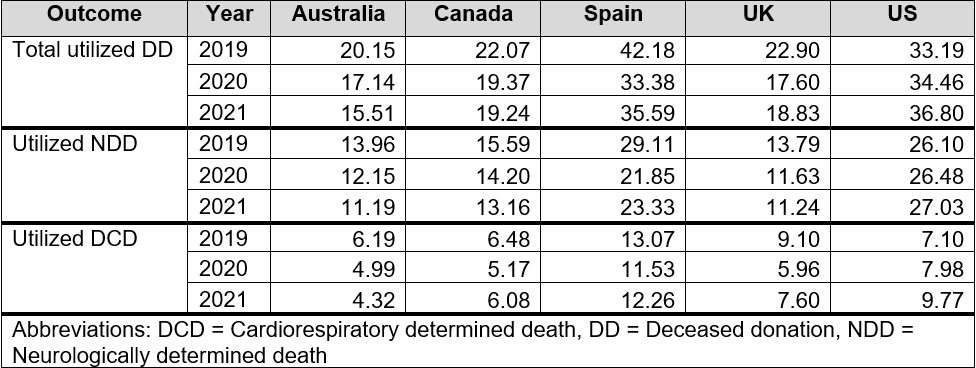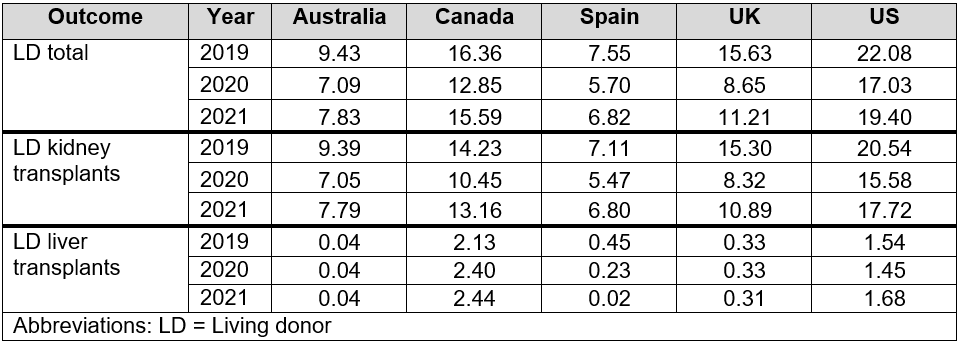Organ donation recovery during the first two years of the covid-19 pandemic: a comparison of Canada with Australia, Spain, the United Kingdom, and the United States
Katrina Sullivan1, Michael Manno1, Frank Ivis1, Nicole de Guia1, Juliana Wu1, Jag Gill2, Karthik Tennankore3, Matthew J Weiss4.
1Canadian Organ Replacement Register, Canadian Institute for Health Information, Toronto and Ottawa, ON, Canada; 2Department of Medicine, University of British Columbia, Vancouver, BC, Canada; 3Department of Medicine, Dalhousie University, Halifax, NS, Canada; 4Department of Pediatrics, Université Laval, Laval, QC, Canada
Introduction: The COVID-19 pandemic challenged organ donation programs around the world, as many health systems shifted resources towards the surge of critically ill COVID-19 patients and limited donation and transplant activity. With signs of health system recovery becoming evident, the aim of this study is to compare organ donation rates between Canada, Australia, Spain, the United Kingdom (UK), and the United States (US) across three periods: pre-pandemic (2019), the first pandemic year (2020), and the second pandemic year (2021).
Methods: Patients registered in the Canadian Organ Replacement Register who donated an organ that was utilized for transplantation in Canada between 2019 and 2021 were identified. For the same time period, aggregated donation data from Australia, Spain, UK and US were obtained from the Global Observatory on Donation and Transplantation. Values for deceased donors (DD) (including neurological determination of death (NDD) donors vs. donors after circulatory determination of death (DCD)) and living donors were compared between countries and across years to determine the impact of COVID-19 on organ donation activity.
Results: Only the US did not experience a decrease in DD following the onset of COVID-19, instead increasing by 12% between 2019 and 2021. Australia, Canada, Spain, and the UK all experienced decreases in DD in the first year of the pandemic (-14%, -11%, -20%, -23%, respectively), and despite some improvements in Spain and the UK in 2021 (+7% for both compared to 2020), none of these four countries have recovered to pre-pandemic levels (Table 1). Canada and Spain experienced a greater decrease in NDD donors than DCD donors from 2019 to 2021 (Canada: -14% vs. -5%; Spain: -19% vs. -6%, respectively), while the opposite was true for Australia (decrease of -29% in DCD and -18% in NDD). The UK saw a similar level of decrease in both NDD and DCD levels (-18% and -16%, respectively). The only country to experience an increase was the US, with a +4% improvement in NDD donors and +39% improvement in DCD donors from 2019 to 2021 (Table 1).

While total living donations in Australia, Canada, Spain, the UK, and the US were all lower in 2021 compared to 2019 (-15%, -3%, -9%, -28%, -11%, respectively) (Table 2), all five countries did experience an increase in living kidney donors in 2021 (+12%, +27%, +25%, +31%, +14%). Further, Canada increased the number of living liver donations in both the first (+14%) and second (+2%) year of the pandemic, while the US had more living liver donations in 2021 compared to 2019 (+10%) (Table 2).

Conclusions: The COVID-19 pandemic impacted organ donation on a global scale. While signs of improvement are already apparent, donation recovery has been unique to each country. More detailed data such as number of eligible donors or rate of consent for donation during the pandemic will be required to understand the causes of these differences.